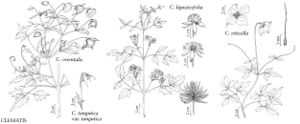Clematis tangutica var. tangutica
Stems climbing, 2-4 m. Leaf blade pinnately 5-7-foliolate, proximal leaflets rarely 3-foliolate; leaflets lanceolate to oblong or elliptic, unlobed or lobed proximally, 1.8-5.7 × 0.4-1.6 cm, margins serrate; surfaces usually abaxially pubescent, not glaucous. Inflorescences terminal and axillary, 1(-3)-flowered. Flowers bisexual; pedicel 0.6-3 cm; sepals ascending, scarcely spreading except near tip (forming narrowly bell-shaped perianth), bright yellow, lanceolate to elliptic, 1.8-3.4 cm, length ca. 2.5 times width, margins silky-pubescent, abaxially silky-pubescent, adaxially glabrous; stamens 20-50; filaments pilose proximally; staminodes absent; pistils 80-150. Achenes turgid, not conspicuously rimmed, pilose; beak 2-4.5 cm. 2n = 16.
Phenology: Flowering summer–early fall.
Habitat: Roadsides, thickets, other ± open, disturbed sites
Elevation: 700-1000 m
Distribution

Introduced; Alta., B.C., Man., Sask., Yukon, native to Asia (China, India).
Discussion
Clematis tangutica var. tangutica, the most commonly cultivated yellow-flowered species of Clematis, should probably be expected elsewhere. It is closely related to, and sometimes treated as a variety of, C. orientalis.
Selected References
None.
